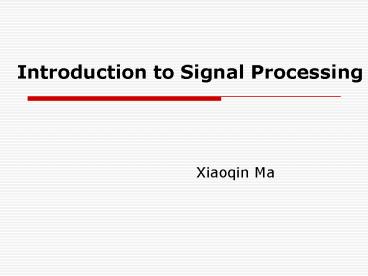Introduction to Signal Processing - PowerPoint PPT Presentation
1 / 17
Title:
Introduction to Signal Processing
Description:
From the mathematical point of view, we can describe a given signal in many ... Ingle, John G. Proakis, Thomson Learing. Matlab Help ... – PowerPoint PPT presentation
Number of Views:599
Avg rating:3.0/5.0
Title: Introduction to Signal Processing
1
Introduction to Signal Processing
- Xiaoqin Ma
2
Contents
- Basic Principle
- Our case-Engine diagnosis
- Frequency Analysis
- Fourier Transform
- Frequency Analysis - Example
- Frequency Analysis - Our case
- Joint Time-Frequency Analysis
- Short-Time Fourier Analysis
- Short-Time Fourier Analysis - Example
- Short-Time Fourier Analysis - Our case
- Wavelet analysis
- Wavelet-example
- Wavelet Analysis-Our case
- Continuing your imagination
- Fractional Fourier analysis
- Fractional Fourier analysis-Example
3
Basic Principle
- From the mathematical point of view, we can
describe a given signal in many different ways,
as the function of time, or as the function of
frequency, which tells us how quickly signal
magnitude changed. - In real applications, frequency presentations,
such as the power spectra, usually have simpler
patterns than time waveforms. For example, the
complex sinusoidal function corresponds to one
pulse in the frequency domain.
This presentation mainly focuses on the
characteristics of signal processing methods and
difference between them rather than rigorous
mathematic equations.
4
Our case-Engine diagnosis
- The objective is to diagnose the current state of
the engine - Choose two signals from settwo1 dataset M and V
signals - M Signal
- Signal obtained from M engine with X
failure mode, which is missed by our model
calculation - V Signal
- Signal obtained from V engine with normal
mode, but has many spikes. The probability of
normal mode is lower than 50 from our model
calculation
5
Frequency Analysis--Fourier Transform
- The Fourier transform, in essence, decomposes or
separates a waveform or function into sinusoids
of different frequency which sum to the original
waveform. It identifies or distinguishes the
different frequency sinusoids and their
respective amplitudes
6
Frequency Analysis-Example
Original Signal sin(2pi50t) sin(2pi120t)
Noise 2randn(size(t)) Noisy Signal
Original Signal Noise
7
Frequency Analysis-Our case
M-X failure
V-Normal
M Signal has higher frequency content than V
Signal, which can be called as characteristic
frequency.
8
Joint Time-Frequency Analysis
- why do we need other techniques, like Joint
Time-Frequency analysis - Fourier analysis has a serious drawback. In
transforming to the frequency domain, time
information is lost. If the signal properties do
not change much over time -- that is, if it is
what is called a stationary signal -- this
drawback isn't very important. - However, most interesting signals contain
numerous nonstationary or transitory
characteristics drift, trends, abrupt changes,
and beginnings and ends of events. These
characteristics are often the most important part
of the signal, and Fourier analysis is not suited
to detecting them.
9
Short-Time Fourier Analysis
- Dennis Gabor (1946) adapted the Fourier transform
to analyze only a small section of the signal at
a time, windowing the signal - Short-Time Fourier Transform (STFT), maps a
signal into a two-dimensional function of time
and frequency - STFT provides some information about both when
and at what frequencies a signal event occurs.
Precision is determined by the size of the window - Drawback is that once you choose a particular
size for the time window, that window is the same
for all frequencies
10
Short-Time Fourier Analysis - Example
linear FM signal x vco(sawtooth(2pit,.75),0.
1 0.4fs,fs)
Frequency
- Plot at the bottom is the time waveform
- Plot on the right is the power spectrum
- Plot in the middle is the
- time-dependent spectrum
- From time waveform, the period of signal changes
with time - From Frequency spectrum, a wide frequency band of
signal appears - From STFT spectrum, frequency changes with time
- Better view can be obtained from STFT spectrum
time
11
Short-Time Fourier Analysis - Our case
M-X failure
V-Normal
Frequency
time
M signal has higher frequency energy during a
period, which may indicate the failure occurring
or will occur
12
Wavelet analysis
The continuous-time wavelet transform (CWT)
a?0
denotes the mother wavelet. The
parameter a represents the scale index that is
the reciprocal of the frequency. The parameter b
indicates the time shifting (or translation).
- Wavelet analysis represents use a windowing
technique with variable-sized regions. - Wavelet analysis does not use a time-frequency
region, but rather a time-scale region.
13
Wavelet analysis -example
- One-stage discrete wavelet transform of a signal.
- s sin(20.linspace(0,pi,1000))
0.5.rand(1,1000)
14
Wavelet Analysis-Our case
M-X failure
V-Normal
High Frequency
Low Frequency
time
time
Signal in d4 carries the failure characteristics
Precursor may appears before failure M signal in
d4 has a big peak with large amplitude V signal
in d4 has small amplitude
15
Continuing your imagination ---Fractional
Fourier analysis
- Consider a one-dimensional signal x(n), and it's
Fourier transform Fx(n)X(w). - Denoting superscripts as the number of
applications of the Fourier operator, we have
F1x(n)X(w), F2x(n) x(-n), F3x(n)X(-w),
F4x(n)x(n). - The Fourier operator can be applied in fractional
increments.
16
Fractional Fourier analysis
- From the figure, the fractional Fourier
transform can be generally understood to
correspond to a rotation in time-frequency phase
space
17
References
- Joint Time-Frequency Analysis, Shie Qian and
Dapang Chen, Prentice-Hall, 1996 - Digital Signal Processing Using MATLAB, Vinay K.
Ingle, John G. Proakis, Thomson Learing - Matlab Help































